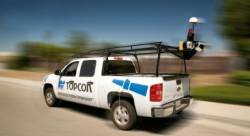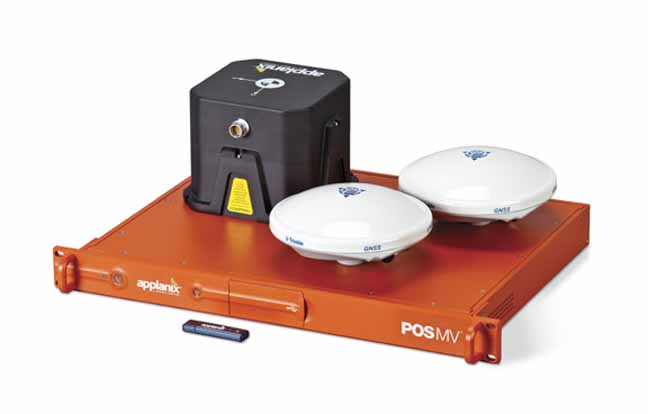 John Ristevski
John RistevskiPrivacy rebellions such as recently drove a Google Street View crew from Broughton, England, or security-oriented legislation that would require blurred features or position accuracy in commercial imagery is just part of the market environment for 3-D mapping company earthmine, Inc., which is moving out of beta mode into full-fledged operations.
Privacy rebellions such as recently drove a Google Street View crew from Broughton, England, or security-oriented legislation that would require blurred features or position accuracy in commercial imagery is just part of the market environment for 3-D mapping company earthmine, Inc., which is moving out of beta mode into full-fledged operations.
Founded in 2006 in Berkeley, California, the privately held company has developed a stereo-panoramic camera array that generates full 360-by-180-degree spherical imagery. The array uses four camera pairs (eight cameras total) mounted vertically and spaced horizontally 90 degrees apart.
Images are typically captured at 10-meter intervals as the vehicle-mounted system is driven down a street or road. After postprocessing, each pixel in the earthmine digital images has an accurate 3D position — reportedly at the meter level for points 20 to 30 meters from the camera.
The camera system incorporates NovAtel SPAN inertial/GPS technology and 3D data generation software and algorithms created by NASA’s Jet Propulsion Laboratory (JPL) and used on the Mars Exploration Rover missions.
The integrated GPS/INS provides accurate position and orientation information for each capture event, says John Ristevski, earthmine’s co-founder and co-CEO. “This is all postprocessed differentially and supplemented with additional data from the imaging systems to get very accurate position and orientation information for the data.”
If needed, multiple image captures can be used to improve pixel positioning accuracy; however, the position data generated with each capture event is usually satisfactory.
Signed late in 2007, the agreement with JPL includes exclusive use of software and algorithms for stereovision systems and camera calibration algorithms as applied to street level mapping and asset management. Risteveski told Inside GNSS that earthmine has been working with JPL over the years to develop techniques for gathering high-resolution imagery in urban environments.
The earthmine camera system is able to operate for limited periods of time using the inertial measurement unit alone when sufficient GPS signals are unavailable, but Ristevski says he’d be interested in enhancing the system with GLONASS capability as well for deep urban environments.
On March 30 at the SPAR 2009 conference, earthmine announced the immediate availability of their new data acquisition hardware platform as well as two partner programs — one for customers who purchase the earthmine hardware (Collection Partner) and the other companies that merely want access to imagery from specific locations (Project Partner).
The mapping company also offers developers two earthmine application programming interfaces (APIs), currently in closed beta mode but expected to be opened up within a few months. The Flash Viewer API supports development of “immersive and interactive spatial experiences” for browser or desktop applications and the Direct Data API for flexible Representational State Transfer (REST)-style access via a web service.
Earthmine is targeting customers in enterprise, government, and eventually consumer application markets for such things as asset management, transportation planning, architectural and engineering projects, local points-of-interest searches and directories as well as other location based services. The company has mapped 12 metropolitan areas in the western United States and has just launched its first overseas foray with a customer.
Most of the development so far has been for desktop computing applications, but the company is supporting efforts to expand the focus to location-aware mobile devices. “GPS on the device can provide approximate location information to display appropriate data and imagery,” says Ristevski.
More sophisticated applications of the pixel-level 3D positioning involve technologies such as image analysis, feature recognititon, and computer vision.
“Some of our customers have experimented with using earthmine data to localize the position of mobile devices using images captured from a camera and feature recognition techniques applied to both the captured image and the earthmine image database, says Ristevski. “This can be used in conjunction with GPS to limit the feature match search.”
As for the issues of privacy and security that have been raised for similar systems, Ristevski says they are just a part of doing business. For instance, in Broughton, England, a citizen objected to the presence of a Street View contractor and called police, according to press reports, leading to the departure of the camera crew.
“I think Google is testing the waters in many countries by deploying Street View there first, which is good for us as they are able to take on any initial legal and cultural backlash that may occur,” says Ristevski.
On the security front, legislation such as California’s proposed bill, AB 255, would require online maps to limit the level of detail for public buildings as a way to thwart potential terrorist attacks.
“In many countries taking pictures from public areas is perfectly legal (such as the US, Australia, UK),” Ristevski points out. “In other places, such as continental Europe, license plate blurring and face blurring is required before these images can be displayed.”
Other nations have even stricter regulations, he says, such as prohibiting source data from leaving the country.
“This is something we definitely respect, and we have developed techniques to meet these requirements so that collection and publication can happen in a legal manner,” Ristevski says. “In general, we will respect and conform to any local law. If the California Bill were to pass (which I think is very unlikely), we would definitely conform to its requirements by blurring public buildings, schools, etc. This adds additional overhead to us but none of it is unmanageable.”
With degrees in geomatic engineering and law from the University of Melbourne, Australia, Ristevski met his co-founder and co-CEO Anthony Fassero while doing doctoral research at the University of Berkeley.
The company’s chief strategy officer is Paul Smith, formerly vice-president at DigitalGlobe, one of only two satellite imagery companies in the world, and before that, chief operating officer at GlobeXplorer.





